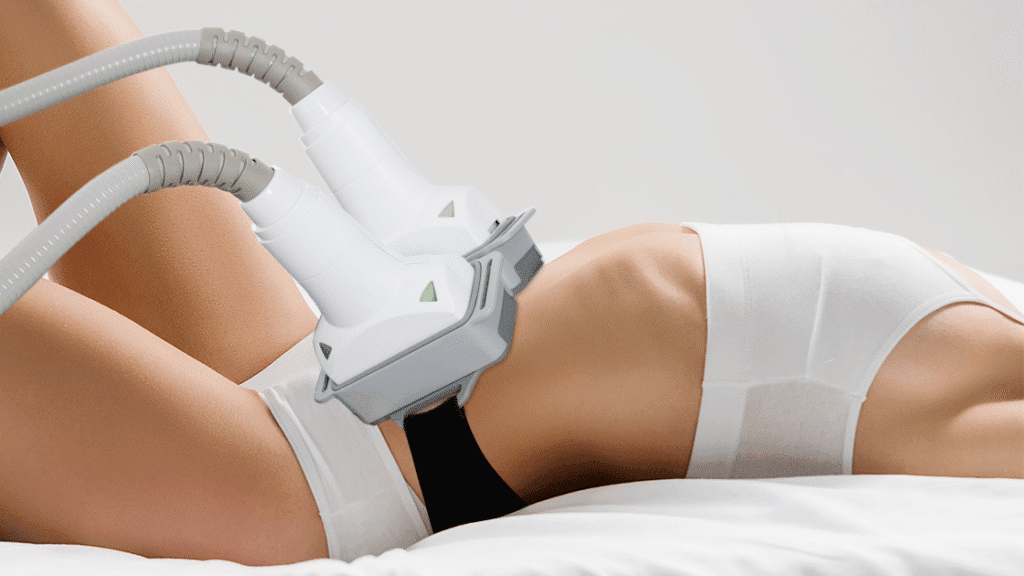1. Introduction: Understanding Mild Obesity and Fat Reduction Needs
Modern obesity management combines metabolic health and aesthetics, as mild obesity often resists diet and exercise alone. Emerging technologies target stubborn fat, enabling clinicians to integrate evidence-based strategies with innovative fat reduction solutions for comprehensive treatment.
1.1 What Is Mild Obesity? Definition, BMI, and Health Risks
Mild obesity, clinically defined as a Body Mass Index between 30 and 34.9 kg/m², represents the first classification within the obesity spectrum according to World Health Organization criteria. This category affects millions globally and carries significant health implications despite being considered “mild.” Patients in this range face elevated risks for cardiovascular disease, type 2 diabetes mellitus, hypertension, dyslipidemia, sleep apnea, and certain malignancies. Additionally, excess adipose tissue produces inflammatory cytokines and adipokines that contribute to metabolic dysfunction and systemic inflammation, creating a cascade of physiological challenges beyond aesthetics.
1.2 Challenges of Traditional Weight Loss: Diet, Exercise, and Motivation
Conventional weight management through caloric restriction and increased physical activity encounters numerous obstacles that limit long-term success. Metabolic adaptation, commonly termed “adaptive thermogenesis,” causes the body to reduce energy expenditure as weight decreases, making continued progress increasingly difficult. Patients frequently experience plateaus where stubborn fat deposits, particularly in genetically predetermined areas, resist further reduction despite strict adherence to healthy behaviors. Psychological factors including stress, emotional eating, time constraints, and diminished motivation compound these physiological barriers, contributing to the approximately 80% recidivism rate observed in traditional weight loss programs within five years.
2. Laser Lipolysis: Overview of the Technology
Minimally invasive technologies like 레이저 지방 분해 address limitations of traditional obesity treatments, offering targeted fat reduction and body contouring without surgery. Providing measurable results with minimal risk and recovery, it bridges lifestyle modification and invasive procedures, supporting safe outpatient care and informed patient expectations.
2.1 What Is Laser Lipolysis? Non-Invasive Fat Reduction Explained
Laser lipolysis, also termed laser-assisted lipolysis or laser liposuction, utilizes specific wavelengths of laser energy to selectively target subcutaneous adipose tissue through thermal and photomechanical effects. Unlike traditional liposuction requiring general anesthesia and significant tissue trauma, this approach employs laser energy delivered through fiber-optic probes or external applicators to disrupt adipocyte cellular membranes. The procedure can be performed with local anesthesia in an office-based setting, significantly reducing procedural risks, recovery time, and healthcare costs while maintaining effectiveness for localized fat reduction and 바디 컨투어링 applications in appropriately selected candidates.
2.2 How It Works: Mechanism of Action on Adipose Tissue
The therapeutic mechanism involves laser energy at wavelengths typically around 1064nm that penetrates tissue to target water and lipid chromophores within adipocytes. This selective photothermolysis generates controlled thermal injury causing adipocyte membrane disruption and triglyceride release through lipolysis. The emulsified lipids are subsequently metabolized through the lymphatic system and processed by the liver for elimination. Simultaneously, the thermal effect stimulates neocollagenesis in the dermis through heat shock protein activation, promoting skin tightening that prevents the laxity often associated with volume reduction. This dual action addresses both fat reduction and tissue remodeling comprehensively.
2.3 Differences Between Laser Lipolysis and Other Fat Reduction Techniques
Laser lipolysis distinguishes itself from alternative body contouring modalities through its unique combination of fat reduction and dermal tightening. Compared to cryolipolysis, which uses controlled cooling to induce adipocyte apoptosis over several weeks, laser technology provides more immediate thermal effects with visible results emerging faster. Unlike radiofrequency treatments that primarily target superficial tissue tightening, laser energy penetrates deeper to directly affect adipose layers. Surgical liposuction removes greater fat volumes but requires general anesthesia, creates significant trauma, and demands extended recovery. Laser lipolysis occupies a middle ground, offering meaningful fat reduction with minimal invasiveness for patients with localized deposits.
3. Benefits of Laser Lipolysis for Mild Obesity
Laser lipolysis offers more than fat reduction, addressing persistent localized deposits, improving aesthetics, function, and psychological wellbeing. When combined with lifestyle changes, it enhances motivation, adherence, and long-term healthy habits, serving as a valuable adjunct in mild obesity management.
3.1 Targeted Fat Reduction: Abdomen, Thighs, Arms, and Love Handles
The precision of laser lipolysis enables selective treatment of anatomically discrete fat deposits that disproportionately affect body contour and patient satisfaction. Common treatment areas include the abdomen, particularly the lower abdomen and flanks where visceral and subcutaneous fat accumulate preferentially due to hormonal influences and genetic predisposition. Thighs, both inner and outer aspects, respond well to targeted laser treatment addressing areas prone to adipose accumulation in gynoid fat distribution patterns. Upper arms, submental regions, and dorsal areas benefit from the combined fat reduction and skin tightening effects, creating improved definition and proportion throughout the treated areas.
3.2 Complementing Lifestyle Changes: Enhancing Diet and Exercise Results
Laser lipolysis functions optimally as an adjunctive intervention that enhances rather than replaces fundamental lifestyle modifications essential for sustainable weight management. Patients who maintain caloric deficits through balanced nutrition and regular physical activity experience superior outcomes, as the treatment addresses residual stubborn deposits while systemic weight loss continues through metabolic pathways. This combination creates synergistic effects where lifestyle changes reduce overall adiposity and improve metabolic health, while laser treatment refines body contour in resistant areas. The visible improvements often strengthen patient motivation, creating positive reinforcement that supports continued adherence to healthy behaviors and long-term weight maintenance strategies.
3.3 Body Contouring and Skin Tightening Effects
Beyond adipose reduction, the thermal effects of laser energy stimulate dermal remodeling processes that enhance overall aesthetic outcomes significantly. Controlled heating of collagen fibers causes immediate contraction and subsequent neocollagenesis over subsequent months, improving skin elasticity and firmness in treated areas. This addresses a common concern in weight loss patients where rapid fat reduction leaves excess skin creating unfavorable contours. The dual mechanism distinguishes laser lipolysis from other non-invasive technologies, providing comprehensive body sculpting that improves both underlying tissue architecture and superficial appearance. Patients typically observe progressive improvement over three to six months post-treatment as remodeling continues.
3.4 Rapid Recovery and Minimal Downtime for Patients
The minimally invasive nature of laser lipolysis allows most patients to resume normal activities within days, contrasting sharply with surgical alternatives requiring weeks of restricted activity and recovery. Local anesthesia eliminates risks associated with general anesthesia including respiratory complications, prolonged sedation effects, and postoperative nausea. Post-procedural discomfort typically remains manageable with over-the-counter analgesics, and most patients return to work within 24-48 hours. Compression garments worn for several weeks support healing and optimize results but do not significantly impair function. This favorable recovery profile makes the procedure accessible to working professionals and individuals unable to accommodate extended downtime periods.
4. Who Can Benefit Most from Laser Lipolysis
Appropriate patient selection is crucial for laser lipolysis success. Ideal candidates have mild obesity with localized fat, realistic expectations, commitment to healthy lifestyles, and suitable anatomy for laser treatment. Thorough evaluation of medical history, body composition, aesthetic goals, and psychological readiness ensures safety and optimal outcomes, while recognizing contraindications and limitations guides patients toward alternative interventions when necessary, supporting evidence-based clinical decisions.
4.1 Mild Obesity with Localized Fat Deposits
Patients with BMI values in the mild obesity range who have achieved relative weight stability through diet and exercise but retain stubborn localized fat deposits represent ideal candidates. These individuals typically demonstrate good skin elasticity, adequate hydration status, and absence of significant medical comorbidities that could complicate healing processes. The presence of discrete fat accumulations in treatment-responsive areas such as the abdomen, flanks, or thighs that remain disproportionate despite overall weight loss indicates appropriate candidacy. Patients should understand that laser lipolysis addresses body contouring rather than significant weight reduction, with realistic expectations regarding achievable outcomes and the necessity of continued lifestyle management.
4.2 Patients Seeking Safe Non-Invasive Fat Reduction and Body Contouring
Individuals who desire aesthetic improvement without accepting surgical risks or extended recovery periods find laser lipolysis particularly appealing. Candidates concerned about general anesthesia complications, surgical scarring, or significant tissue trauma benefit from this minimally invasive alternative. Patients with demanding professional or personal obligations requiring rapid return to normal activities appreciate the reduced downtime profile. Those seeking gradual, natural-appearing improvements rather than dramatic transformations often prefer the subtler results achieved through laser technology. Additionally, patients who previously underwent bariatric surgery or significant weight loss and require contour refinement in specific areas without comprehensive body lift procedures represent an important candidate population.
4.3 Contraindications: Health Conditions Requiring Medical Evaluation
Several medical conditions preclude or require careful consideration before laser lipolysis treatment to ensure patient safety and optimize outcomes. Active infections, particularly in proposed treatment areas, necessitate resolution before proceeding. Patients with bleeding disorders, therapeutic anticoagulation, or taking medications affecting hemostasis require hematologic evaluation and possible therapy modification. Pregnancy, lactation, and plans for near-term pregnancy contraindicate elective body contouring procedures. Individuals with photosensitivity disorders, recent sun exposure, or active skin conditions in treatment areas need dermatologic assessment. Severe obesity (BMI >40) typically requires more comprehensive weight management before considering laser lipolysis, and unrealistic expectations warrant additional counseling or treatment deferral.
5. Treatment Protocols and Practical Considerations
Successful laser lipolysis requires tailored treatment plans considering body composition, skin quality, target areas, and aesthetic goals, combined with patient education and post-procedure care to ensure safety, realistic expectations, and long-term results.
5.1 Typical Session Duration, Frequency, and Number of Treatments
Individual laser lipolysis sessions typically range from 30 to 90 minutes depending on treatment area size, number of zones addressed, and specific technology employed. Most patients require between one and three treatment sessions spaced 6-8 weeks apart to achieve optimal results, allowing adequate time for tissue healing and collagen remodeling between interventions. Single large-area treatments may suffice for modest fat reduction goals, while more comprehensive body contouring requires multiple sessions targeting different anatomical regions sequentially. Practitioners assess initial response at 6-8 week follow-up appointments to determine if additional treatments would enhance outcomes. Maintenance sessions may be recommended annually or biannually for patients wishing to sustain results long-term.

5.2 Combination with Lifestyle Modifications: Diet, Exercise, and Hydration
Maintain a moderate caloric deficit with balanced macronutrients including lean proteins, complex carbs, and healthy fats.
Emphasize whole foods rich in vitamins and minerals to support overall metabolic health.
Engage in regular cardiovascular and resistance exercise to promote fat loss and preserve muscle mass.
Stay adequately hydrated to facilitate lymphatic drainage and support skin remodeling.
Limit alcohol and processed foods while managing stress to optimize treatment results.
Prioritize sufficient sleep to enhance metabolic function and tissue recovery.
5.3 Post-Treatment Care: Skin Health, Activity, and Follow-Up
Resume light activity immediately but avoid strenuous exercise for 3–5 days post-procedure.
Begin gentle massage one week after treatment to aid lymphatic drainage and prevent nodules.
Keep treated areas hydrated with moisturizers and adequate water intake to support healing.
Attend scheduled follow-ups at 2, 6, and 12 weeks to monitor progress and outcomes.
6. Clinical Evidence and Case Studies
The growing clinical evidence for laser lipolysis demonstrates its efficacy, safety, and high patient satisfaction across multiple anatomical sites. While large randomized trials are limited, prospective studies, comparative research, and systematic reviews support its use. Real-world outcomes further confirm achievable fat reduction and body contouring results when appropriate protocols, patient selection, and post-treatment care are followed, providing practical guidance for clinicians integrating laser lipolysis into mild obesity management and aesthetic practice.
6.1 Research Evidence: Effectiveness in Mild Obesity Management
Published literature demonstrates laser lipolysis achieves measurable fat reduction ranging from 2-6 centimeters in circumferential measurements across treated areas, with results correlating to energy parameters and treatment protocols employed. Histological studies confirm adipocyte disruption, reduced adipose tissue thickness, and increased dermal collagen density following laser treatment. Patient satisfaction rates consistently exceed 80% in studies with appropriate candidate selection and realistic expectation management. Comparative studies suggest laser technology produces superior skin tightening compared to other non-invasive modalities, though surgical liposuction removes greater fat volumes. Long-term follow-up data indicate results remain stable when patients maintain healthy lifestyle behaviors, supporting the role as adjunctive rather than standalone obesity intervention.
6.2 Real-World Patient Outcomes: Before and After Results
Clinical practice outcomes mirror research findings when evidence-based protocols and appropriate patient selection guide treatment decisions. Patients typically observe initial improvements within 2-4 weeks as inflammation resolves and early fat metabolism occurs, with progressive enhancement continuing for 3-6 months as collagen remodeling advances. Circumferential reductions of 1-3 inches in abdominal measurements represent common outcomes following complete treatment courses. Skin texture improvements become evident as dermal thickness increases and elasticity improves. Photographic documentation reveals enhanced body contours, reduced protrusions in previously problematic areas, and improved overall proportion. Patient testimonials frequently emphasize psychological benefits including increased confidence, motivation for continued healthy behaviors, and improved clothing fit that reinforces positive lifestyle changes.
6.3 Testimonials and Practitioner Insights
Experienced practitioners consistently note that patient education and expectation management correlate strongly with satisfaction outcomes in laser lipolysis applications. Clinicians emphasize that realistic goal-setting, clear communication regarding required lifestyle commitments, and honest discussion of achievable results prevent disappointment and enhance overall experience. Many practitioners incorporate standardized photography, circumferential measurements, and sometimes ultrasound imaging to document objective improvements that may not immediately appear dramatic to patients. Successful practices implement comprehensive consultation processes assessing candidacy, reviewing medical histories thoroughly, and ensuring patients understand the adjunctive nature of treatment. Practitioners also note that combining laser lipolysis with nutritional counseling, exercise programming, and behavioral support optimizes outcomes substantially.
7. Potential Risks, Side Effects, and Safety Precautions
Laser lipolysis is generally safe, but potential risks exist and require patient awareness. Most side effects are mild and temporary, including redness, swelling, or slight discomfort. Rare serious complications can occur, making proper patient selection, informed consent, and adherence to safety protocols essential. Clinician expertise and protocol compliance help minimize risks while ensuring effective fat reduction and body contouring outcomes.
7.1 Common Mild Side Effects: Redness, Swelling, Temporary Discomfort
Transient redness at treatment sites usually resolves within hours to a few days.
Localized swelling may occur for 5–14 days as fat tissue undergoes natural clearance.
Mild soreness, tenderness, or bruising-like discomfort is common but manageable with OTC pain relief.
Temporary numbness or altered sensation may appear due to minor nerve irritation and resolves over weeks.
7.2 Rare Complications and How They Are Managed
Burns or thermal injury can occur from excessive energy and require immediate cooling and wound care.
Infection at treatment sites is rare but needs prompt antibiotics and monitoring.
Contour irregularities like asymmetry or dimpling may develop and sometimes require revision.
Seromas or fluid buildup may form and can require aspiration.
Prolonged inflammation beyond normal recovery should be evaluated for underlying issues.
8. Integrating Laser Lipolysis into a Long-Term Weight Management Plan
Sustainable obesity management requires holistic strategies combining behavior, metabolism, and psychology. Laser lipolysis complements lifestyle optimization by targeting stubborn fat deposits and enhancing motivation. Long-term success depends on ongoing monitoring, periodic adjustments, and patient engagement with evidence-based diet, exercise, and weight maintenance strategies to prevent regain and improve overall quality of life.
8.1 Monitoring Progress and Adjusting Lifestyle Strategies
Regular assessment through objective measurements including weight, body composition analysis, circumferential measurements, and photographic documentation provides essential feedback guiding treatment optimization and lifestyle modifications. Patients benefit from scheduled follow-up appointments at standardized intervals allowing practitioners to evaluate response, address barriers to adherence, and adjust dietary or exercise recommendations based on individual progress patterns. Monitoring metabolic markers including lipid panels, glucose homeostasis measures, and inflammatory biomarkers documents systemic health improvements accompanying aesthetic changes. Digital health technologies including activity trackers, nutrition logging applications, and telemedicine platforms facilitate continuous engagement and early identification of concerning trends requiring intervention. This longitudinal approach prevents small deviations from escalating into significant regain.
8.2 Maintaining Results: Diet, Exercise, and Periodic Treatments
Maintain a balanced caloric intake 10–15% above weight loss phase to prevent new fat accumulation.
Emphasize nutrient-dense whole foods, portion control, and consistent healthy eating habits.
Engage in at least 250 minutes of moderate-intensity exercise weekly for long-term weight maintenance.
Include resistance training to preserve lean muscle mass and support metabolic rate.
Consider periodic maintenance laser lipolysis every 12–24 months for minor fat re-accumulation.
Use behavioral strategies like self-monitoring, social support, and cognitive techniques to prevent relapse.
8.3 Psychological Benefits: Motivation, Confidence, and Body Image
The psychological dimensions of body contouring interventions often prove as significant as physical changes for overall wellbeing and weight management success. Visible improvements in body contour frequently catalyze enhanced self-efficacy regarding health behavior changes, strengthening beliefs about personal capacity for sustained lifestyle modification. Improved appearance often increases social confidence, willingness to engage in physical activities, and overall quality of life measures. Enhanced body satisfaction may reduce emotional eating triggers and improve adherence to healthy behaviors through positive reinforcement mechanisms. However, practitioners must remain vigilant for unrealistic expectations, body dysmorphic concerns, or disordered eating patterns that contraindicate aesthetic interventions until psychological stability is established through appropriate mental health support.
9. Conclusion: Safe and Effective Fat Reduction for Mild Obesity
Laser lipolysis offers safe, minimally invasive fat reduction for patients with mild obesity, targeting stubborn adipose deposits resistant to diet and exercise. Ideal for those with stable weight yet localized fat, it enhances body contouring and skin tightening while supporting aesthetic and motivational goals. Clinical evidence shows improvements in circumference, contour, and skin quality when proper protocols and patient selection are applied. Best used as an adjunct to comprehensive weight management—including nutrition, exercise, and behavioral strategies—laser lipolysis provides rapid recovery, minor transient side effects, and minimal risk compared to surgery. Sustained results depend on continued healthy lifestyle adherence, making this technology a scientifically supported bridge between non-invasive methods and surgical interventions, improving both appearance and overall metabolic health.







